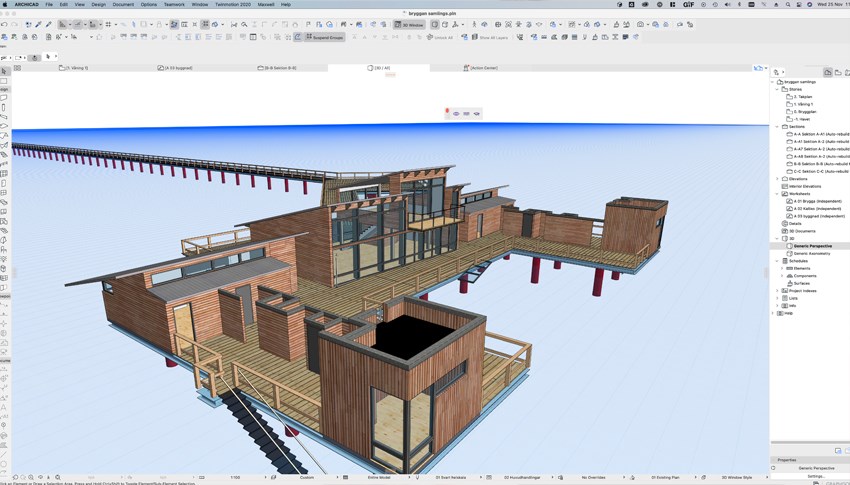
Marta Gutiérrez considers herself an atypical architect who prefers to get her shoes dirty at the construction site rather than design in an office. Before becoming a BIM Consultant, she worked for many years at MVN Arquitectos in Madrid, where she carried out projects such as the Palacio de los Condes de Villagonzalo (the Palace of the Counts of Villagonzalo). Her broad BIM experience brought her to BIMobject, where she assists manufacturers such as Electrolux, AEG, Zanussi, and Luznor in developing their digital libraries.
In other words: Marta knows a thing or two about BIM, so let’s jump in:
Why do architects and engineers use BIM?
First things first. Suppose you’re interested in hopping aboard the BIM train. In that case, you need to understand what purpose it serves and what benefits it brings to architects, engineers, and construction professionals. For that, let’s hand over the mic to Marta Gutiérrez:
“For me, the main benefit of BIM is the accuracy in accounting for the enormous amounts of materials required on a construction site,” she says and adds:
“With AutoCAD, you need to go floor by floor and calculate each area to know how many square meters of lumber is needed for flooring. With BIM, that information is stored within the model, with a chart that directly computes the square meters of flooring you have used in the design. As a result, budgets are far more tailored and accurate.”
Another well-known benefit of BIM is that it offers architecture, engineering, and construction professionals the possibility to mitigate errors in a virtual environment. Marta elaborates:
“Architects and engineers work on the same 3D model, allowing them to visualize the problems that may arise on-site in advance. BIM makes it possible to solve issues before they occur – reducing waste of materials and avoiding delays, which ultimately drive up the project’s budget. This accurate preview of the actual model also makes it easier to understand and sell the project to the client.”
The benefits don’t stop at planning and design. BIM can also simplify processes throughout all construction phases.
“For example, maintenance software can be linked to the model to alert you to safety checks of fire extinguishers or elevators. Also, If you change all the furniture in an office building, you can have all the up-to-date information with a couple of clicks: manufacturer contact, installation instructions, and so on. For all this to work, of course, it’s necessary to design using BIM objects from the manufacturer that incorporate all this information into the model,” states Gutiérrez.

How can manufacturers become a part of BIM?
Architects, engineers, clients, property owners, and construction professionals are reaping the BIM benefits. But what about manufacturers?
“We see manufacturers becoming increasingly convinced that they must develop BIM objects – it’s what the market demands. Spain’s Public administration, encouraged by the European Union, has already included BIM as a requirement in projects,” says Marta.
Spain is one of many nations propagating and mandating. Spain, Italy, and Argentina have set an iterative roadmap in motion, while Denmark, the UK, and Brazil have mandates in place. But a lack of a legal requirement doesn’t equal laggard uptake – the US proves that point to the T. Gutiérrez comments:
“Manufacturers realize that they must implement BIM objects to participate in public projects and in many other private projects where BIM is used. BIM is a must if you want to partake in these tenders.”
Is BIM a requirement in your markets? Get the guide on global BIM mandates now >
Why do manufacturers hesitate to develop BIM content?
According to USP, 44% of European architects used BIM in 2021. The same source predicts 61% will use the digital building process by 2025. BIM software is nearly accepted as the industry norm in the US, and 54% of professionals in Japan have used BIM.
Adoption is on a roll. But, architects and engineers are voicing frustration: manufacturers are falling behind on supplying manufacturer-specific BIM content. Marta Gutiérrez comments:
“The main barrier for a manufacturer to start with BIM is a lack of knowledge. It is, of course, different if the manufacturer has BIM technicians in-house. In that case, the decisions to develop digital objects are made much faster as the BIM technicians know the methodology and its benefits.”

What do manufacturers need to provide to develop BIM objects?
Simply put: BIM objects are information-rich digital replicas of your products. But what information is needed in the BIM content development process?
“We need the product data sheets, 3D or 2D reference files, as well as the materials and textures of the product to develop BIM files,” says Marta Gutiérrez, and adds:
“It’s beneficial for the manufacturer’s project manager to have a technical profile or a good understanding of the product to make the process smoother – especially for complex products such as electronics.”
Once the information is sent over, the BIM experts in the content development team put in their technical how-how and optimize the file for the intended users:
“Once we have the information and knowledge on how the product works, we study which features are essential for the professional downloading the BIM file. This way, we avoid excessive information or complexity that could hinder its use in a project,” says Marta.
Find out how BIM consultants made a world’s difference for Precision Ladders >
Detail or data: what should manufacturers prioritize?
Marta explains that some manufacturers investing in BIM content are worried about the geometric appearance of products – wanting the 3D BIM object to look as true to form as possible. However, Gutiérrez emphasizes that design detail isn’t the maker or breaker of deals:
“The critical aspect of a BIM object is that it includes the product’s information, materials, and textures. This makes a huge difference when selling a project preview to a client.”
Construction data is a critical part of the decision-making and product selection processes. However, it can quickly become too much of a good thing:
“Designing every last bolt or including all product features will create a file that’s too large or contains information that the designers don’t need. We have to think about what is most useful for the user,” says Marta.

Revit or Archicad?
The file format is another critical factor to consider when developing BIM objects. There are multiple BIM software out there, used by various industry segments and sometimes in different phases of the construction process.
As a manufacturer, you want to secure that the right professionals can use the BIM content you spent time and money developing. Chances are that you’ve heard of Revit and Archicad, right? Well, that’s probably because they’re the most commonly used BIM software systems. But make no mistake: Archicad and Revit differ in operation and intended use. Marta Gutiérrez explains:
“Broadly speaking, Archicad is more visual and versatile and focuses more on the architectural side than the engineering side, and therefore does not permit some calculations that Revit can do. This is why some products, such as electrical or HVAC equipment, are more useful in the Revit format than Archicad.”
Marta says that manufacturers often hesitate between developing BIM objects in Revit or in Revit and Archicad. She comments:
“When the manufacturer asks the content development team for advice on Revit vs. Archicad, we often ask them how many users the company wants to reach. We always recommend developing BIM objects in both formats so that the manufacturer can reach as many users as possible,” says Gutiérrez, and adds:
“Architectural firms that work with Revit often do not work with Archicad – and vice versa. So, the ideal solution would be to have both. If the budget is tight, priority is usually given to development in Revit, which is the most widely used BIM software system.”
Extending file format availability is often demand-driven. Marta explains that it’s common for a manufacturer, who might have started with just Revit, to receive a request from a user interested in getting the products in an Archicad file format. More often than not: the manufacturer ends up developing both.
How can manufacturers develop BIM content smoothly?
The development of BIM files requires time, knowledge, and resources. BIMobject’s BIM content development team has more than a decade’s experience in BIM content development and knows it can feel overwhelming for manufacturers new to BIM.
“My advice to manufacturers who want to develop BIM for the first time and don’t know where to start is to contact us for advice. As BIM Consultants, we aim to give manufacturers the best possible ‘BIM life’ for their products,” concludes Marta Gutiérrez, BIM Consultant at BIMobject.










